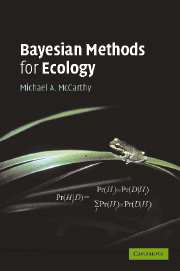2 - Critiques of statistical methods
Published online by Cambridge University Press: 05 June 2012
Summary
Introduction
Statistics in the discipline of ecology is dominated by null hypothesis significance testing. Apart from the construction of confidence intervals, it is almost the only statistical method taught in ecology at the undergraduate level. In leading ecological and conservation journals, such as Conservation Biology, Biological Conservation, Ecology and the Journal of Wildlife Management, null hypothesis testing has been used in approximately 90% of articles between 1978 and 2001 (Anderson et al., 2000; Fidler et al., 2004), although this proportion was only 80% in 2005 (Fidler, 2005). Since 1980, there have been several thousand null hypothesis tests (on average) reported each year in Ecology (Anderson et al., 2000), a further illustration of the dominance of this method. In comparison, only about 5% of ecological articles refer to Bayesian methods and even fewer use them (Fig. 1.1).
Despite its dominance, null hypothesis significance testing has ardent critics. There are alternatives but their use is controversial. In this chapter, I review three different methods of statistical analysis that are used in ecology (see also Oakes, 1986). These are null hypothesis significance testing, information-theoretic methods, and Bayesian methods. Readers will not be surprised, given the topic of this book, that I believe there are clear advantages in using Bayesian methods, although not necessarily to the total exclusion of others. However, I will first present an example that further illustrates some of the differences and similarities of the statistical methods.
- Type
- Chapter
- Information
- Bayesian Methods for Ecology , pp. 30 - 62Publisher: Cambridge University PressPrint publication year: 2007



